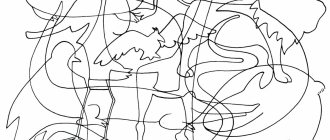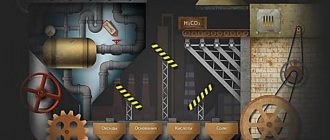Description of the test Pictogram according to the A.R. method Luria
Alexander Romanovich Luria is a follower of Lev Semenovich Vygotsky, one of the founders of Russian neuropsychology. The Pictogram test, developed by him as part of the development of this area of science, allows us to identify the features of memorization through associative connections. The objectives of the study are:
- identifying the nuances of indirect memorization;
- assessment of memory productivity;
- determining the nature of mental activity;
- studying the level of development of imaginative thinking.
The technique is not used for diagnosing preschoolers and primary schoolchildren, but is only suitable for testing among subjects with at least 67 years of education.
BASICS OF PICTOGRAM DATA INTERPRETATION
The interpretation of pictogram data consists of a qualitative analysis of each pictogram image with a formalized assessment of the latter; assessing the quantitative relationships of images of various types in a given protocol; taking into account analytical factors that are not available for formalization (special phenomena), including the graphic features of the pictogram. The final stage is the synthesis of available data and formulation of a conclusion.
Qualitative analysis of the pictogram. When qualitatively analyzing pictogram images, the content of the picture, factors of abstractness, individual significance of standardization and adequacy are taken into account. Since in a qualitative analysis it is necessary to give an unambiguous assessment of each image, accessible for formalization, short letter designations are assigned to each category of pictogram images.
A summary table of these designations is given in
appendix 2.
Abstractness factor.
Concrete images (K). The general quality of this group of images is their correlation with a specific situation. A direct image of the situation associated with the concept is a specific photographic image (K - Ft), for example, a warrior walking with a grenade towards a tank for the concept of “feat”, a lover with a bouquet of flowers under his watch for the concept of “deception”.
Most of the drawings containing the image of an entire human figure belong to specific images. Despite the relative economy of the image, for example, a person digging for the concept of “hard work,” the subject here also depicts a specific situation - a person is working. All individually significant images also relate to specific ones, regardless of the nature of the image, since in them the subject refers to a specific situation from his experience. Thus, test subject L. draws a doll, a book and a gramophone record for the concept of “deception,” since she uses these objects “when feeding a child in order to deceive him.”
Finally, some of the pictogram images, being specific, do not have significant connections with the proposed concept; the connection is “confabulated” by the subject. The most common such images (specific confabulatory ones - K - Kf) are related to the concept of “doubt”. Subject S. draws a stool for this concept. Explanation: “I doubt whether this stool is made of wood or plastic.”
Attributive images (At). These images are selected on the basis of belonging and attribution. Thus, the concept of “merry holiday” is depicted with a flag, a glass, and a carnival mask. There is no longer an attempt to directly depict the concept or the situation associated with it. Most attributive images are economical in terms of visual means.
Metaphorical images (M). This category includes images where an essentially abstract association is expressed indirectly, through a specific object. In most cases, the connection is metaphorical in nature; it may be based on a literary image. Examples of these images are a crossed out clock for the concept of “happiness” (“happy people don’t watch clocks”), an index finger and an arrow around it for the concept of “deception” (“circle one’s finger”). A metaphor can be created by the subject directly during the study. Thus, subject A. draws a corkscrew for the concept of “doubt” (“doubt, like a corkscrew, screws into you and does not allow you to live in peace”).
Geometric, graphic and grammatical symbols (GS). Here the abstract association also corresponds to the method of its expression - a symbol related in content to the concept. Often these symbols reflect spatial characteristics - direction, symmetry. Such symbols have a high specificity for the concept (arrows diverging to the sides for the concept of “separation”, an axis of symmetry for the concept of “justice”). Other symbols reflect only the emotional component of the concept - symbols of valence (minus sign for the concept of disease, dark shading for the concept of “deception”).
Symbols can be generally accepted, or less commonly, they are produced during the course of the study. The basis for classifying an image as a symbol is precisely the abstract type of association, and not the geometric nature of the image. Thus, subject V., for the concept of “doubt,” drew a circle divided in half, one half of which is shaded. Explanation: “I doubt whether it is black or white.” Based on the level of abstraction, this image should be classified as concrete (confabulatory).
Factor of individual importance.
The evaluation of images taken from the individual experiences of subjects is of considerable interest. The very fact of direct appeal to personal experience is important. It is in the individually significant images of the pictogram that the projective elements of the method are most directly realized. In these images, subjects directly talk about their interests, desires, and intentions. Individually significant images can project the current experiences of patients, including delusional ideas and suicidal tendencies. Individually significant images are heterogeneous in nature.
Individually significant personified images (Ind-Ps). Personified images should include those that depict the subject himself, a scene with his participation, a part of his body, and, less often, images of other specific individuals.
Thus, subject K., whose right leg is amputated, draws a picture of a person without a leg for the concept of “disease.” Patient S., in response to the concept of “deception,” draws a portrait of a doctor who promised to discharge him and did not fulfill his promise.
Sometimes personified images have a clear kinesthetic coloring (Ind-Kn). The meaning of the concept in this case is conveyed precisely by the pose and movement of the person. Most images depicting a person in motion lack individual significance, so they are not truly kinesthetic. This is especially true for the transmission of facial movements (a sad facial expression in response to the concept of “sadness” is an attributive image devoid of individual significance).
It is necessary to directly indicate to the subject that the movement is associated with his individual experience. As in the Rorschach test, subjects often show movements before starting to draw, which is a sign that the image is kinesthetic.
Individually significant stimulus images (Ind-S). These images do not contain the image of a person. These are images of objects that “stimulate” the subjects’ memory of a specific situation from their individual experience associated with the proposed concept.
Thus, subject Sh., who is fond of mountaineering, draws mountains based on the concept of “happiness.” Explanation: “I usually get a feeling of happiness in the mountains.” Subject N. draws a letter on the concept of “separation”. Explanation: “I’m separated from my family, but letters help me a lot.”
Formally selected images (F). This group includes images that lack individual significance.
Contents of the drawing.
To paraphrase G. Rorschach, we can say that they draw “everything possible, and patients with schizophrenia also paint everything that is impossible.” We will limit ourselves to listing the most significant analytical categories.
Scenes with human participation - Stsu human figures - B, parts (details) of the human body - BH, small parts of the human body rarely found in the pictogram (eyes, mouth, feet, etc.) - BH, inanimate objects - BUT, fauna - Fn, flora - fd, landscapes - P, architecture, art - I, symbols - S.
Selection frequency factor.
This purely statistical criterion indicates the relative frequency of choice in the protocols of healthy subjects. Given the natural frequency distribution of choices, it is advisable to classify the pictogram image into one of three categories.
Standard images (St)—occurring more often than 20 out of 100 protocols.
Original images (Orig) - found less often than in 2 out of 100 protocols.
Repetitive images occupy an intermediate position in frequency between standard and original ones. They do not have a letter designation.
Detailed information on the frequency distribution of images is contained in Appendix 2.
Adequacy factor.
The adequacy of the image of a pictogram is a complex qualitative factor, including the similarity of the image and concept in content, moderate abstractness, brevity of the image and explanation. At the same time, one should proceed not only from theoretical assumptions, but also from actually obtained data - which pictogram images are naturally chosen by mentally healthy people. An image that falls into the repetitive category should not be classified as inadequate. Adequate images are indicated by a “plus” sign, and inadequate ones by a “minus” sign (Orig—).
Formalized assessment of pictogram images.
Based on a qualitative analysis of the pictogram image, a formal assessment is carried out on all factors. Here are some examples.
The concept of "victory". Fireworks are depicted. Explanation: “Fireworks happen on Victory Day.” The choice is attributive, not having individual significance, the choice is standard, adequate. Formalized assessment: At St + salute. Another example (from the study protocol of a patient suffering from schizophrenia). The concept of "hard work". A triangle is shown. Explanation: “In our department, there are three people who do hard work—the boss, his deputy and me.” A specific choice (despite the geometric nature of the image), individually significant, original, inadequate. Formalized assessment: K Ind Orig - S.
Appendix 2 provides a formalized assessment of all standard and repetitive, as well as some original (both adequate and inadequate) images for the set of concepts we use. At the beginning of working with the method, these tables can serve as a practical guide for a pathopsychologist.






